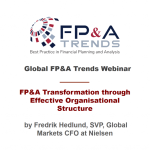Fredrik Hedlund, SVP, Global Markets CFO at Nielsen, who is responsible for more than 105 countries...
 FP&A (sometimes called Management Accounting, Business Control etc.) is the business-facing part of finance. This means Financial Planning and Analysis (FP&A) professionals are providing an essential “business” service.
FP&A (sometimes called Management Accounting, Business Control etc.) is the business-facing part of finance. This means Financial Planning and Analysis (FP&A) professionals are providing an essential “business” service.
While FP&A challenges to FP&A around access to good quality data, leveraging better technology for more powerful analytical ends and cutting across internal finance silos have been well documented, relatively little has been written about the environment that FP&A works within. And how that can help FP&A have more impact or less.
Why is it important?
Pressure on business is growing, with pretty much every sector seeing significant increases in complexity and uncertainty.
This demands an increase in the quality of decision making and execution and learning based on feedback loops. This is the essential service of FP&A.
Compare this situation with the the past where FP&A service was likely limited to merely Management Reporting. Now it matters more – there is a clear connection between setting expectations and playing a part in making it happen.
What is needed for modern FP&A to flourish?
Changing expectations is not enough, the new expectations have to crystallise to reality. It’s like planting a new seed and nourishing it. Will you do this on a barren or fertile soil?
A fertile soil for modern FP&A requires a shift in eight categories and this shifts come with their own demands:
1) service delivery based on reporting 🡲 adding strategic value
This demands a level of discomfort in business to accept a strong voice and opinion from FP&A.
2) decision making based on the gut feeling 🡲 the more data-driven process
This demands a data and analytic culture and investments.
3) post rationalizing (looking backward) 🡲 scenario building (looking forward)
This demands accepting uncertainty and risk and tolerating these.
4) safe and certain mindset (controlling to confirm) 🡲 acceptance of calculated risk mindset (controlling to learn)
This demands embracing failure as something not to be penalized.
5) short term (targets) 🡲 longer term rolling (strategic) perspective
This demands focus on the things that matter.
6) low expectation (not really part of team) 🡲 accountability (integral part of team)
This demands a holistic, integrated approach.
7) a cost centre 🡲 a profit centre
This demands a move away from just ROI to would you pay for the advice externally.
8) information is power (especially numbers) 🡲 transparent communication linking numbers to future positive outcomes and realistic risks
This demands a level of trust in organization.
How can FP&A encourage this culture change?
The challenge of change from one culture or environment to another should not be underestimated. Intention is always easier than action. This broader culture change in the organization can result in FP&A having a bigger impact. How can FP&A achieve this?
- Continually improve the “product” of FP&A. Learn to be experimental, test, try and re-iterate but focus on the core elements of the service and its delivery.
- Work on change management. Learn to become good change leaders and agents. Remember that changing perspectives, whilst a critical first step, is always easier than changing habits.
- Take (more effective) ownership of the planning & control cycle. These are the moments where the opportunities are there to help shape how the organization changes its perception and approach to performance management.
- Remain vigilant for examples of over-complicatedness in decision making. Look, for example, in places where many people can say no but no one seems to be able to say yes. Find ways to get this complexity on the table and make it transparent.
- Lead by example when it comes to learning – use both premortems and post mortems on areas of significant investments or complex change projects.
- Communicate and market successes in the improvement in both the FP&A service but, critically, on crediting the conditions that have allowed that success to happen.
What about technology and digitalization?
This is more about leadership than technology per se.
Nevertheless, technology and digitization are forcing organisations to re-invent, which in turn adds pressure for culture to evolve. Both forces can support FP&A to set out the necessary conditions and drive towards an enhanced service.
The key implication, however for FP&A is that they can help by being at the front of these two forces themselves.
A final word
For FP&A, to continue to re-invent itself and become what the organization wants and needs it to be, a change in the organization culture and environment is necessary in many cases. I hope that in this article I have illustrated what some of the change elements can look like and how FP&A themselves can help support such a change.
The article was first published in Unit 4 Prevero Blog
Subscribe to
FP&A Trends Digest

We will regularly update you on the latest trends and developments in FP&A. Take the opportunity to have articles written by finance thought leaders delivered directly to your inbox; watch compelling webinars; connect with like-minded professionals; and become a part of our global community.






